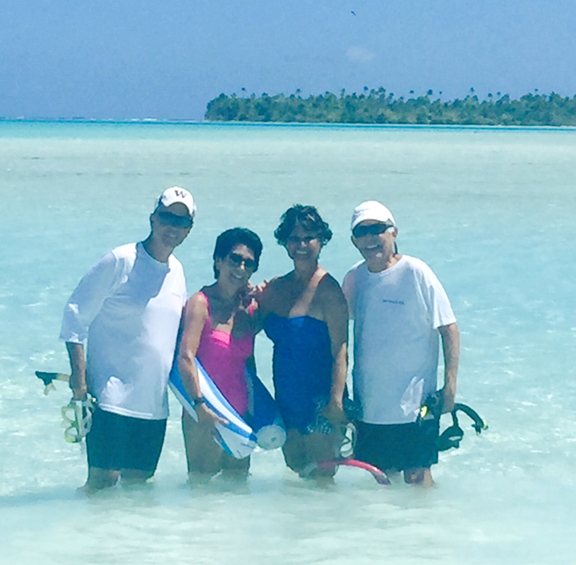
You haven’t received much news from me, not because there isn’t anything happening, but because we’ve been through a weather washing machine for the last few weeks. It hasn’t been the idyllic sail through the South Seas that I had anticipated or remembered from years back.
During the 70-mile sail from Rangiroa to Ahe, a small coral atoll, we hit winds of about 20 knots, making for huge swells and choppy seas. It was by far the toughest sailing that we have experienced yet, and unfortunately, it was the first taste of open-ocean sailing for John and Elise on this trip.
Checking the temperature daily
Climate change and El Niño are certainly big reasons for this ferocious weather and changing weather patterns. I’ve been checking the water temperature daily, and it is now averaging between 86 to 88 degrees Fahrenheit. When you have warm water like this, a lot of it evaporates into the upper atmosphere, which leads to rain, heavy winds and all the tremendous weather challenges that we have been experiencing in this part of the world.
Heating up with no relief in sight
The Double X is also heating up in the galley and berths. In fact, it must be in the 90s. Normally we open the hatches for air circulation, but when it rains, they need to stay closed. So, not only are we continuously rocking and rolling, we are also heating up. Sounds like the ingredients for a good dance? Not really!
Fishing and diving is difficult with all the turbulence stirring up the sand and making the water murky, and paddle boarding and kayaking are totally out of the picture. If you put somebody on a paddle board or in a kayak, they can easily disappear into the distance, and you’ll have to rescue them. It’s very dangerous. Even when you are swimming, you have to be careful to avoid being blown away. So, we are pretty much hanging around the boat, which is a tough because it’s very warm.
It’s all about timing … and a skilled crew
Navigating our way into Ahe was also tricky. This ring-shaped coral atoll in the northern Tuamotu Archipelago has one small passage to enter into the lagoon. Not only is it difficult to navigate, but your timing needs to be right. Captain Bob and the crew did a great job managing our passage into the lagoon, but the Double X took a bit of a beating during this part of the trip.
With all that, you may wonder why we decided to visit Ahe in the first place? Well, this tiny atoll is a place of fond memories for me.
Ahe, 40 years ago
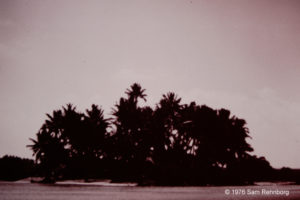
Years ago, when I visited Ahe, the highlight of my visit was meeting Bernard Moitessier. He was a famous French sailor who sailed around the world a number of times. He wrote about one of his sailing trips in the classic book, The Long Way. (You’ll find it in our Learn More Section: Sailing Resources.)
When we met, Bernard was living with his wife and baby daughter on a little motu in Ahe where they were attempting to go back to nature. He was a highly educated man who was alarmed at where civilization was heading, where the consumption of outrageous quantities of the earth’s resources would eventually lead.
Bernard felt deeply that people should return to a simpler life to preserve their environment. He attempted to live totally off the land with his own vegetable garden and fish traps. He cut 50-gallon containers in half, filled them with dirt he brought back from Papeete in his sail boat, and grew cucumbers, lettuce and other vegetables.
When we met, he had been living on Ahe for a number of months. I remember I was concerned about his nutrition, so I gave him a couple boxes of Nutrilite DOUBLE X. He was extremely pleased with the gift and, on the day we left, he told me in broken English, “Sam, thanks a helluva lot for those vitamins.”
Ahe, today
Ahe looks pretty much the same today, although it has weathered a bit and the population has increased by about 30 percent. One big change is the pearl business. Forty years ago, there were no oysters to be found, but now, there must be a hundred thousand buoys in the water with nets where the oysters are growing. It’s big business here, and you’d expect that wealth to show up in the community, but I don’t think it is. I believe the money goes into the pockets of those who get the pearls in the United States and other places.
During our brief stay, we had the chance to visit the place where Bernard Moitessieur lived. It’s still there, but the fish farms that once graced the water are gone and now there are some buildings on the motu. It looks quite different than I remember. His cousin still lives on the property and his daughter is now a doctor in Papeete.
Surrounded by black pearls
Today, many islands in French Polynesia are involved in the pearl industry. I fear that the industry will plummet if the islanders are not cautious. If you do much shopping, you might notice that black pearls seem to be everywhere. Black pearls are now cultivated in this part of the world, in Australia and just about any place oysters are able to grow. As the market becomes flooded, the value of the pearls will rapidly decline.
If I could make a wish, I would wish that the insight Bernard Moitessier shared years ago — the idea of getting back to nature and becoming more sustainable — would shine through and take hold in this community. It would be ideal to see a unique pearl industry farm developed here where some of the wealth can stay in the community. With the right research and marketing, it could be a very romantic story about authentic pearls from the beautiful atoll of Ahe.
What’s next?
We made the return trip back from Ahe to Rangiroa and are drying out a bit before heading to the remote island of Sauvage. From there, we plan to visit Bora Bora, Tahiti and other Society Islands. We had originally planned to visit more of the isolated islands in the Tuamotu Archipelago, but we decided it was best to change our plans with such challenging weather. Change seems to be our only constant these days.
That’s it from now. I’ll report back once we arrive in Bora Bora.
With love,

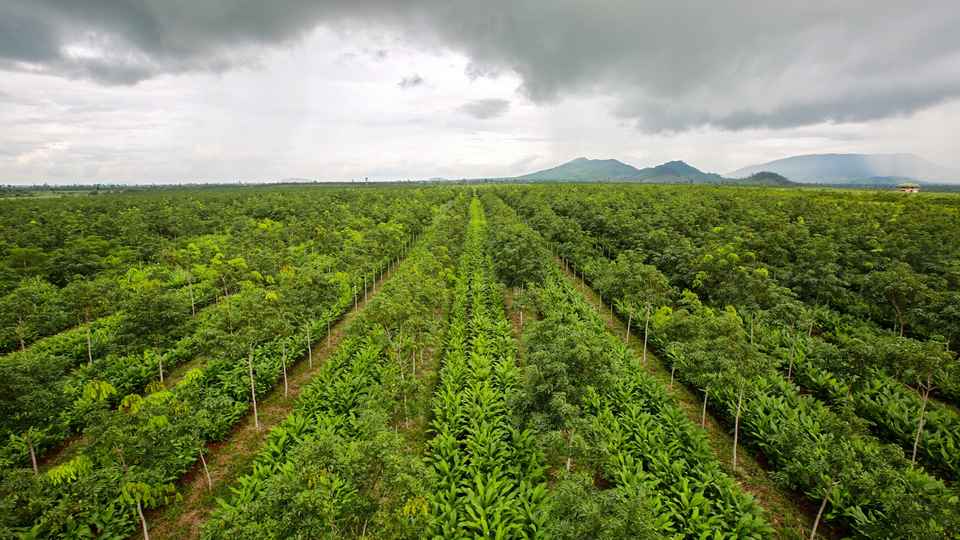
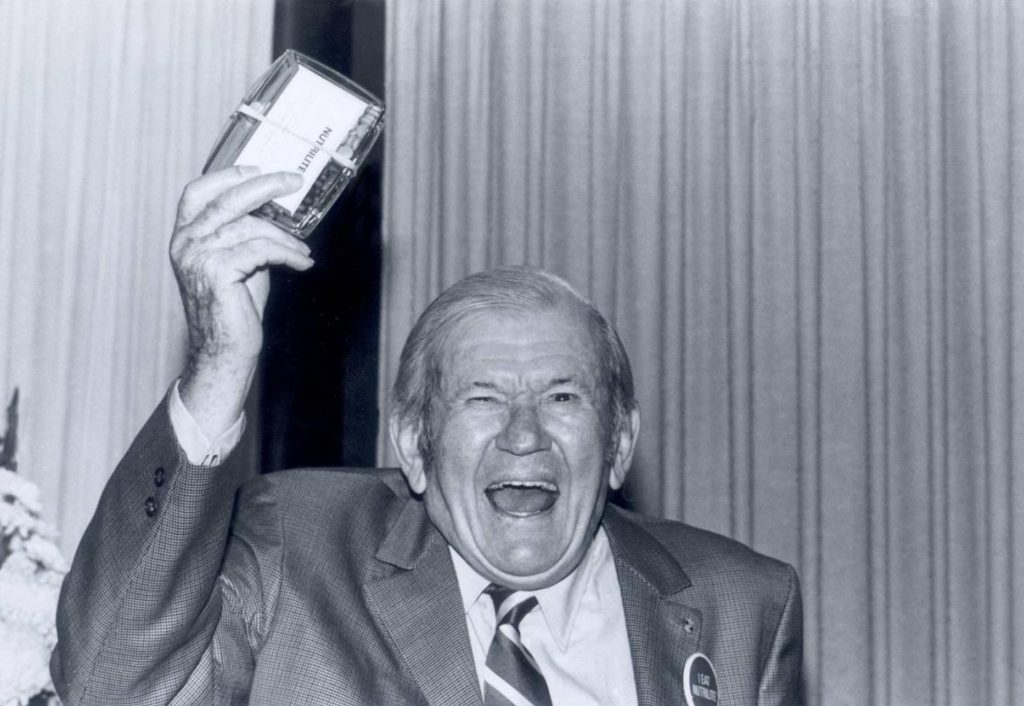
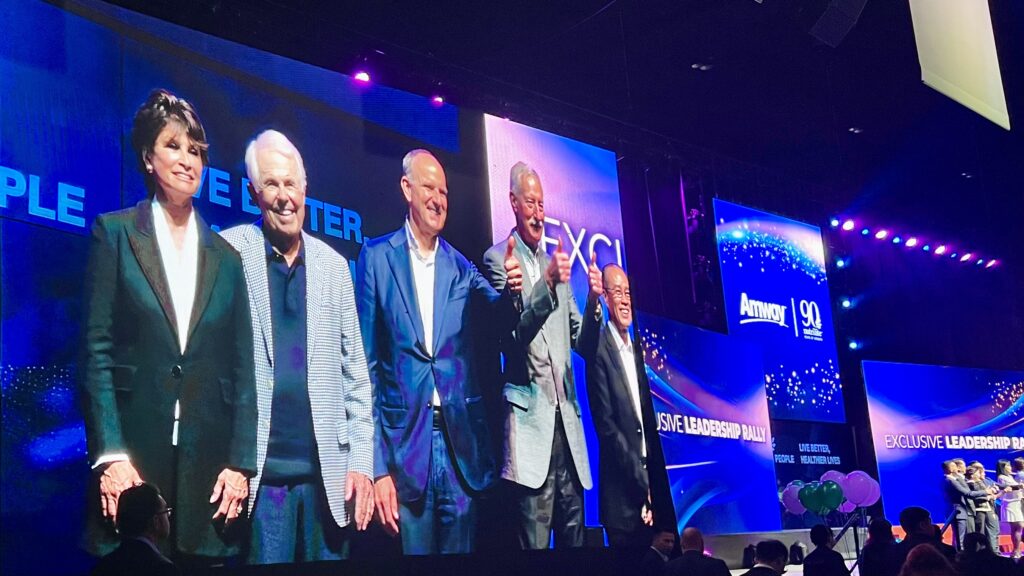
9 Responses
Another great blog – fascinating reading. Some rough seas to test Double X and she meets them all with flying colours!
Sad to read about Bora Bora, but wonderful that Tahaa remains unspoiled. I’ll never eat a vanilla ice cream without thinking about Tahaa!
Your adventures are amazing – keep it going!
With best wishes to you both,
Gordon and Jackie
Sam and Fran,
Congrats on sailing through the storms and unusually warm waters! Know your sailing patterns and can imagine the LOG is full of interesting experiences!
Football has been rough this year, but we’ve been there so many times. It was great to see the TRIBE come back against the Irish!
Thanks for the updates and look forward to seeing you both in November!
Mac
Neat stories. Stay Safe! Frank Hook
Have a beer on me at Bloody Mary’s on Bora Bora—-Ken Berry
Hi Sam
Wonderful website; really enjoying your comments. Sorry that you are having such rough weather and heat.
We are thankful that we will be following in your wake in January aboard the 43,000 ton behemoth Sirena. Actually I wish we were on a 100,000 ton ship as the Sirena was bounced around on our last trip to Bermuda, tables and passengers overturned and for one day we had to run before the storm! Our love to Francesca and yourself. Stay safe.
Reg
Hi Sam,
Thank you so much for your updates. I’m stoked that you aren’t out there short handed.
Hello to everyone.
Best Regards,
Porter and Doris
You’re a fantastic writer, Sam. I love reading your blogs. Say Hi to Francesca for me. Miss seeing you both.
Sam,
The cultural and geological changes after four decades are interesting and profoundly relevant.
We can attribute the success and service of your old friend’s daughter to your supply of vitamins and nutrients in her developing childhood!
Looking forward to seeing you and Francesca in the not too distant future.
Peter
Dr. Sam,
I love following along on this trip…..it makes me want to go back ASAP. I really loved visiting Blue Lagoon, walking to the Bird Island on the coral for a mile….then walking back in a crazy rain storm for lunch in the hut, and the yellow tip sharks….what a wonderful place to visit.